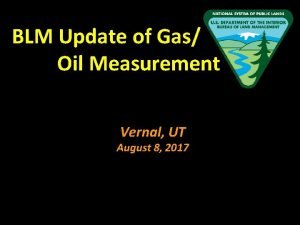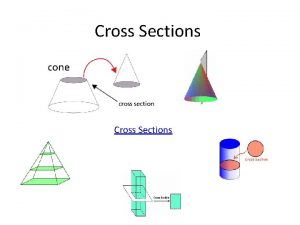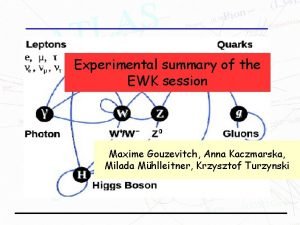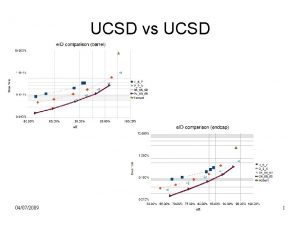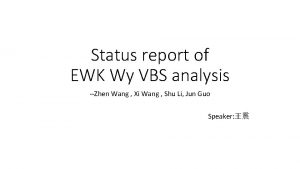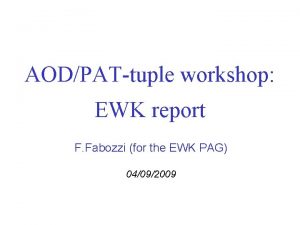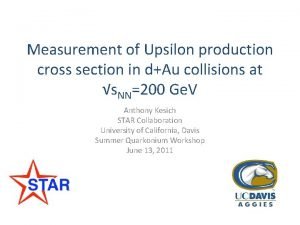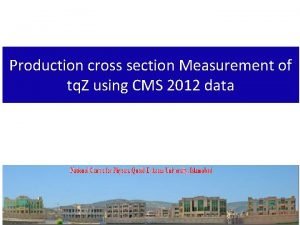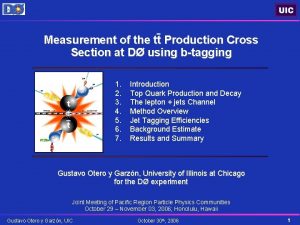First measurement of EWK Z2 j production cross


















- Slides: 18

First measurement of EWK Z+2 j production cross section and hadronic activity in rapidity gap in CMS A. Nikitenko (IC) for 7 Te. V Analysis Team March, 2013

Public PAS. Paper is under CWR

EWK Z + 2 jet production Bremsstrahlung VBF multiperipheral Large, negative interference between VBF and others two processes s EWK mmjj = 255 fb, mll > 50 Ge. V, p. Tj > 10 Ge. V, |hj|< 7. 0, mjj > 120 Ge. V s VBF H->tt = 80 fb for m. H=125 Ge. V

Backgrounds 1. Dominant: high order as corrections to DY production: “QCD Z+jets” 2. Small: tt~ production 3. Small: diboson production:

Analysis strategy • Signal is very small (S/B ~ 0. 1 after optimized selections), therefore • Use different methods to extract signal • Confirm signal in mm and ee modes • Use different methods of jet reconstruction • JPT jets • PF jets

Event selection cut flow table Uncertainty on the dominant background QCD Z+jets due to JES , +13%, -9% is comparable with the signal. The signal must be extracted from the distributions, most sensitive to the presence of the signal

• Signal is extracted by two methods • from fit of mjj • from fit of BDT output

mjj fit; mm mode S +/- stat B +/- stat JPT jets 1. 14+/-0. 28 0. 869+/-0. 008 PF jets 1. 14+/-0. 30 0. 897+/-0. 008

Signal extraction from fit of BDTD output Variables for BDTD 1. p. TJ 1 2. p. TJ 2 3. |h. J 1 -h. J 2| 4. mjj 5. p. TZ 6. y* = y. Z – (y. J 1 + y. J 2)/2 7. h. J 1+h. J 2 8. y. Z 9. |f. J 1 -f. Z| 10. |f. J 2 -f. Z| 11. |f. J 1 -f. J 2| Pre-selections for BDTD: |hj| < 3. 6 9

BDTD output fit; mm and ee modes mm mode ee mode S +/- stat B +/- stat JPT jets 0. 90+/-0. 19 0. 905+/-0. 006 PF jets 0. 85+/-0. 18 0. 937+/-0. 007 PF jets 1. 17+/-0. 27 0. 957+/-0. 010

measured cross sections agrees with NLO prediction (VBFNLO): 166 fb at mll > 50 Ge. V, p. Tj > 25 Ge. V, |hj|< 4. 0, mjj > 120 Ge. V

Section: Hadronic activity in rapidity gap

Check theory expectations with data • Jet activity in rapidity gap for QCD Z/W+jets: • the larger Dhj 1 j 2, the bigger probability to have additional jet in h region between j 1 and j 2 • the larger p. T of tagging jets, the bigger probability to have additional jet in h region between j 1 and j 2

<Njets> vs Dhjj

Conclusions • First measurement of EWK Z+2 j process demonstrates the CMS detector and analysis capability to extract a process which is topologically similar to VBF Higgs production and has a cross section comparable to that in the standard model. • First analysis of hadronic activity in the rapidity interval between forward and backward jets in Z+jets process shows good agreement with Mad. Graph predictions

Difference in kinematics for EWK Z+jets, VBF H and QCD Z+jets

• Expected Feature 1 • the larger p. T of tagging jets, the bigger probability to have additional jet(s) between them • data confirms simulation predictions

Expected feature 2 The larger rapidity separation between tagging jets, the bigger probability to have additional jet(s). data confirms simulation predictions
 Diagram alir proses produksi
Diagram alir proses produksi 43 cfr 3174
43 cfr 3174 First call resolution definition
First call resolution definition Test cross and back cross
Test cross and back cross Test cross and back cross with example
Test cross and back cross with example Complete dominance
Complete dominance Monohybrid dihybrid difference
Monohybrid dihybrid difference In the cross, in the cross be my glory ever
In the cross, in the cross be my glory ever Anti monson curve
Anti monson curve Bill perry designs
Bill perry designs Red cross first aid champions
Red cross first aid champions Red cross emergency medical responder
Red cross emergency medical responder First aid champions red cross
First aid champions red cross Maturity continuum examples
Maturity continuum examples Recursive breadth first search
Recursive breadth first search Sdl first vs code first
Sdl first vs code first Put first things first activities
Put first things first activities Put first things first
Put first things first Difference between code first and database first approach
Difference between code first and database first approach

